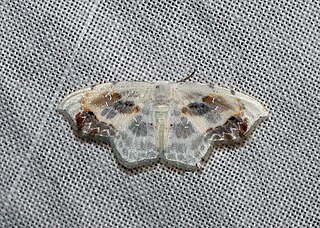
Apamea remissa, the dusky brocade, is a species of moth of the family Noctuidae. It is distributed throughout Europe and Turkey, ranging across the Palearctic realm to Siberia, Manchuria and Japan. It has also been reported from Alaska.

Mythimna albipuncta, the white-point, is a moth of the family Noctuidae. The species was first described by Michael Denis and Ignaz Schiffermüller in 1775. It is distributed throughout Europe and one subspecies is found in Tunisia. It is also found in Asia Minor, Armenia, and Iran, and the northeastern United States.

The Essex y is a moth of the family Noctuidae. It is found from Italy to Greece, southeastern Europe, southwestern Russia, the southern parts of the Ural, Africa, Canary Islands, Arabia, southwestern Asia, Ceylon, from India to Nepal, southeastern China and Japan.

Apamea anceps, the large nutmeg, is a moth of the family Noctuidae. The species was first described by Michael Denis and Ignaz Schiffermüller in 1775.

The double-spot brocade is a species of moth of the family Noctuidae. It is found in most of Europe, in Turkey and the west of Iran. In Anatolia it is represented by the subspecies Meganephria bimaculosa pontica.
Ulopeza denticulalis is a moth in the family Crambidae. It was described by George Hampson in 1912. It is found in South Africa.
Argodrepana verticata is a moth in the family Drepanidae. It was described by William Warren in 1907. It is found in New Guinea.
Euphalacra nigridorsata is a moth in the family Drepanidae. It was described by Warren in 1897. It is found in the north-eastern Himalayas.
Hyalospectra grisea is a moth in the family Drepanidae. It was described by William Warren in 1906. It is found in New Guinea.
Leucoblepsis neoma is a moth in the family Drepanidae. It was described by Swinhoe in 1905. It is found in Singapore and on Peninsular Malaysia, Sumatra and Borneo.

Leucoblepsis renifera is a moth in the family Drepanidae. It was described by Warren in 1900. It is found on Peninsular Malaysia, Sumatra and Borneo.
Strepsigonia affinis is a moth in the family Drepanidae. It was described by Warren in 1897. It is found in Peninsular Malaysia and Borneo.
Strepsigonia nigrimaculata is a moth in the family Drepanidae. It was described by Warren in 1897. It is found in western Malaysia.
Gogana abnormalis is a moth in the family Drepanidae first described by Warren in 1897. It is found on Borneo, Sumatra and Peninsular Malaysia.
Phalacra albilinea is a moth in the family Drepanidae. It was described by Warren in 1899. It is found in India.
Epipsestis castaneata is a moth in the family Drepanidae. It was described by Warren in 1915. It is found in Sikkim in India, Hunan in China and in Nepal and Vietnam.
Habrona caerulescens is a moth in the family Drepanidae. It is found in New Guinea, where it has been recorded only from the Star Mountains.
Habrona papuata is a moth in the family Drepanidae. It is found in Papua and Papua New Guinea, where it has been recorded from mountainous areas.
Takapsestis curvicosta is a moth in the family Drepanidae. It is found in Assam, India.

Cotana meeki is a moth in the family Eupterotidae. It was described by Walter Rothschild in 1917. It is found in New Guinea.






